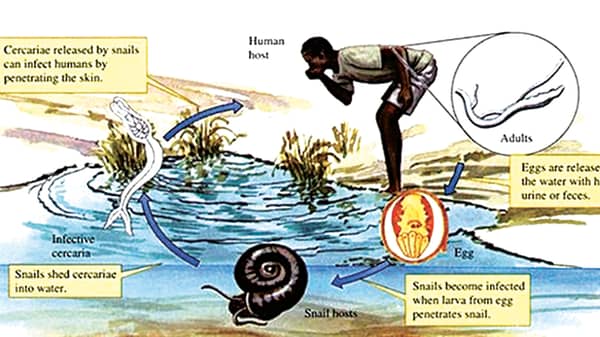 Dr. Olufela Oridota, a Consultant Public Health Physician/Epidemiologist at Lagos University Teaching Hospital (LUTH), in this interview with GERALDINE AKUTU, talked about Schistosomiasis and how it can be managed.
Dr. Olufela Oridota, a Consultant Public Health Physician/Epidemiologist at Lagos University Teaching Hospital (LUTH), in this interview with GERALDINE AKUTU, talked about Schistosomiasis and how it can be managed.
What are the causes of Schistosomiasis?
Schistosomiasis, also known as Bilharziasis, is one of the diseases classified as neglected tropical diseases. It is a disease caused by the worm schistosome that lives in the blood vessels of the intestines or the bladder. There are different species of this worm, including Schistosoma haematobium, Schistosoma mansoni and Schistosoma Japonicum, among others.
It has a worldwide distribution, affecting about 200 million people in 74 countries in Africa, South America and Asia. Schistosoma mansoni occurs mainly in Africa, the Middle East and South America. Schistosoma haematobium occurs mainly in Africa and the Middle East, while Schistosoma japonicum occurs mainly in South-East Asia.
Nigeria is thought to have the highest number of people living with the disease, affecting over 20 million people. Schistosoma haematobium is more prevalent in Nigeria, with a wide distribution along the Niger River Basin, Southwest, Central and Northeast Highlands and the Chad Basin.
Schistosoma mansoni is less prevalent in Nigeria, but also with a wide distribution. Delta, Edo, Ebonyi, Enugu, Nasarawa and Plateau States, are known to bear the greatest burden. Males and females are equally affected. A very high proportion of the infection occurs in school-age children, adolescents and young adults. Transmission occurs throughout the year.
How is Schistosomiasis transmitted?
Transmission occurs when humans come in contact with contaminated fresh water bodies in their daily activities, such as drinking, bathing, laundry, fetching water, swimming, fishing, rice farming and mining, among others. The larva of the worm in contaminated water penetrates an intact skin of the victims and finds its way to the blood vessels of the intestine or the bladder, depending on the species and develops into an adult worm.
This may lead to intestinal or urinary schistosomiasis, as the case may be. Infected persons pass out the eggs of the worm in faeces or urine, which could contaminate fresh water bodies in places with poor sewage disposal and develop into another form of the worm. This new form of the worm now develops further in fresh water snail, the intermediate host and re-emerges from the snail to infect humans.
What are the signs and symptoms of Schistosomiasis?
The symptom of schistosomiasis begins with the skin itching (swimmer’s itch), which occurs when a form of the worm penetrates an intact skin. Infection may be asymptomatic, but when symptomatic, symptoms usually appear two to three weeks after exposure and depend on the affected organ. A common symptom is a blood in urine or faeces. Others include abdominal pain, malaise, fever, urticaria, joint pains, cough and diarrhoea, among others. Chronic infection may lead to liver cirrhosis, bladder cancer, kidney obstruction, chronic urinary tract infection, anaemia, seizure disorder, breathlessness and coughing up blood, among others.
How is Schistosomiasis diagnosed?
Definitive diagnosis is made, when the urine or stool sample of someone presenting with symptoms suggestive of schistosomiasis is examined under a microscope for the eggs of schistosome. Other tests that can be done include rectal biopsy, ELISA, cystoscopy and ultrasonography, among others.
How can Schistosomiasis be controlled?
This involves treatment of infected persons, proper sewage disposal, elimination of vector, prevention of human contact with infected water, health education and community participation.
The drug of choice for the treatment of schistosomiasis is praziquantel. A single dose of 40mg/kg has been demonstrated to be efficacious in eradicating the adult worm. However, a divided dose of 60mg/kg has been demonstrated to be safe in some endemic countries. The drug is highly active against the adult worm. Therefore, treatment is usually delayed until about six to eight weeks, following exposure. In highly endemic communities, control programmes can embark on annual dose or biennial dose for the people within the communities.
Proper sewage disposal is another key intervention in the control of schistosomiasis, as the exit route of the egg of the worm from an infected person is the urine or the faeces. Constructions of sanitary toilets in endemic communities have contributed to the control of schistosomiasis. This should be coupled with behavioural change communication targeting open defecation.
Elimination of the vector, the different species of fresh water snail, is known as an effective measure in reducing the prevalence of the disease. This can be achieved through eliminating their breeding places, such as draining swamps or through the use of chemicals, the molluscicides-Baylucide. The molluscicides are preferable to be applied over a small area of fresh water bodies, based on expert knowledge, rather than over a wide area to reduce pollution.
Prevention of human contact with the contaminated body of fresh water can be achieved through the provision of alternative source of water and health education. The sinking of wells or boreholes in highly endemic communities has been a key intervention in this regard. In situations where exposure to contaminated fresh water is unavoidable, protective clothing, such as rubber boots should be worn, especially for fish and crop farmers.
Health education targeting behavioural change in key affected population is also an important strategy in the control of schistosomiasis.
Health education should make the people in highly endemic communities see it as a problem, explain ways of transmission and behaviours that can fuel transmission, ways of preventing it, the available treatment and where to get it.
Sustainability of any schistosomiasis control programme is rooted in community participation. The community must be involved right from the planning stage of the control programme. They must see it as their own problem and should be involved in proffering solutions for the control. Any drug distribution programme must be community-led.






